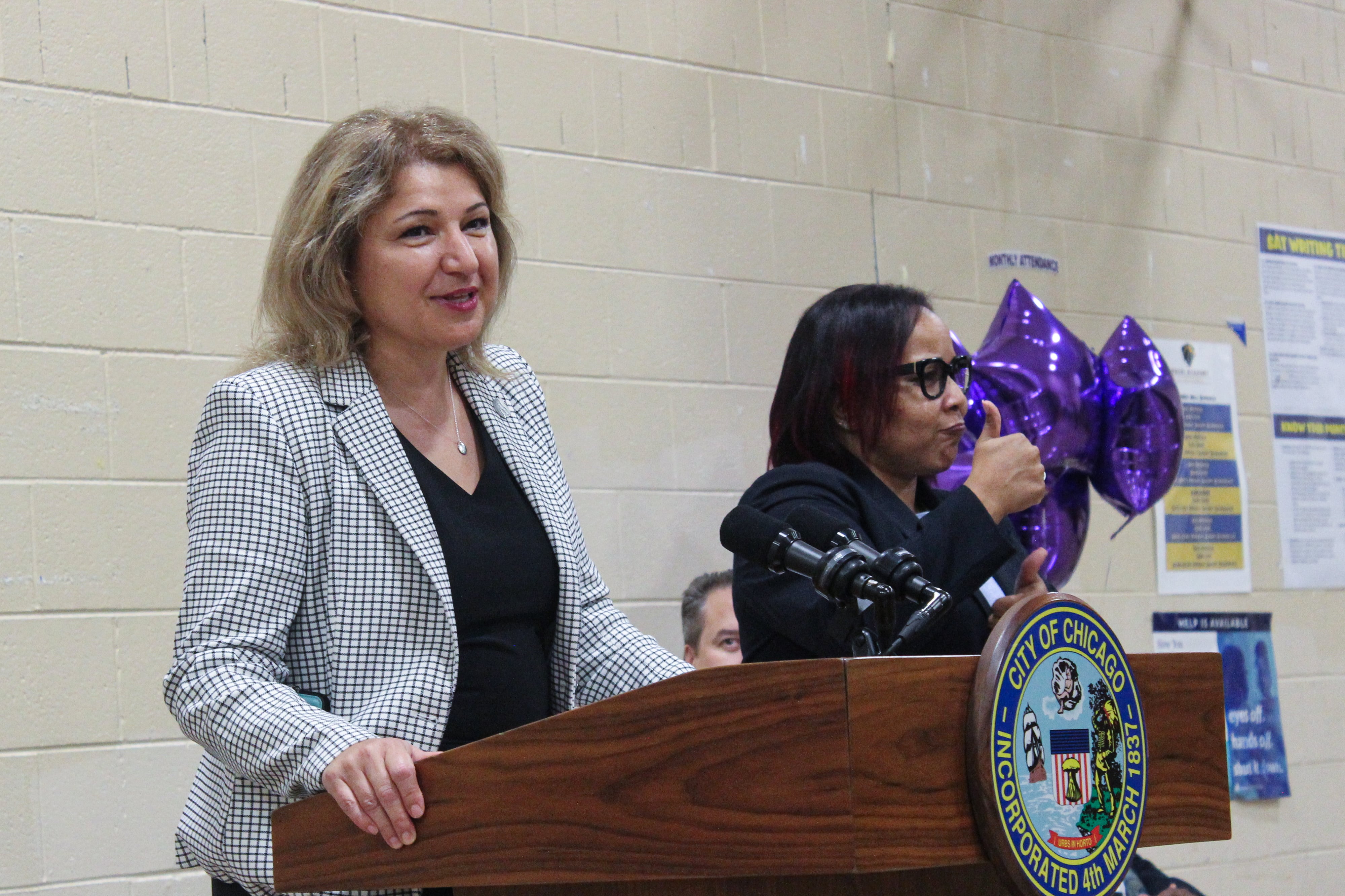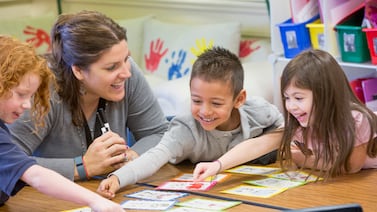Like other urban districts, Chicago Public Schools is tackling academic and mental health recovery from the pandemic in earnest after last school year’s persistent disruptions. And it continues to face long-standing challenges, from racial disparities in student outcomes and lackluster college completion rates.
So, earlier this year, when CEO Pedro Martinez was looking for a chief education officer – his second-in-command – he wanted a CPS stalwart and pragmatic problem-solver. He chose Bogdana Chkoumbova.
Raised and college-educated in Bulgaria, Chkoumbova started out in the district more than two decades ago as a special education teacher at Chopin Elementary on the West Side. She later served as Disney II Magnet School’s founding principal and spearheaded the North Side elementary’s expansion into the high school grades.
She moved on to roles in central administration in 2016, including as a member of the district’s bargaining team during contentious negotiations with the teachers union in 2019 and as chief schools officer before Martinez promoted her in January.
Chalkbeat Chicago spoke with Chkoumbova about what schools need as they recover from the pandemic, the district’s plan to bounce back and reimagine learning, and the roadblocks it must overcome.
You have served as a special education teacher, a principal, a network chief, and chief schools officer. How did these different roles prepare you to step in as the district’s No. 2 as it comes out of the pandemic?
Through my roles, I’ve continued to stay focused on the student experience. I also really value my experience in both elementary and high schools, and my respect for the differences in the school communities throughout Chicago. But at the end of the day, the vision and the goals that everyone has are very similar. After the setbacks that we had in the last couple of years, I think it’s a really exciting moment, not only to go back to a strong foundation and apply everything that we know how to do well as an educational system. But it’s also an opportunity for us to think about innovation — a newer, deeper, and broader vision for what student success looks like.
We have seen a tension between the yearning to get back to normal after all the pandemic upheaval — and the sense that we shouldn’t go back to a normal that did not work for many students. How can the district rethink what learning looks like in Chicago?
While the pandemic deepened some of the opportunity gaps, they were persistent and existing for a very long time. So clearly, all the strategies we’ve used in the past were not sufficient to eliminate these opportunity gaps. We need to think differently.
One initiative I can highlight is having a unique curriculum (Skyline, an initiative of former CEO Janice Jackson) that is culturally responsive and uplifts our students’ identities and their lived experiences in their neighborhoods and communities. One of the areas where I think we have the most opportunities, and we have not really solidified our approach, is the role of the student in the learning process. This year, we’re really thinking about deep student engagement in a more focused way, in our classrooms, but also outside the classroom. We want to support our students to feel that sense of belonging to their school community.
We had a really great summer engagement for our students. More than 91,000 students participated in programs. What made a difference is that we decided that this time around, we would support our schools to design their own summer programs that are more aligned with unique needs that they see for their students.
Another area where I’m really thinking about innovation is opportunities to expand access for students. In the last couple of years, we really doubled down on providing access to algebra for middle school students. We did this in a variety of ways, such as virtual classes and engaging high school teachers to teach in a hub model. It proved to be very successful.
How much do we know about where students stand academically post-pandemic?
We see in assessment data from the state that many of our students are far from proficiency in certain areas, and we are definitely very concerned about catching up. But I think one of the primary areas of focus right now — to make sure that we support our students to accelerate their learning — is strong social-emotional learning supports, helping them to rebuild relationships. I think one of the hardest consequences from the pandemic is actually social isolation. Learning is a social enterprise.
We are doubling down on making sure that we have strong classroom instruction, at grade levels and in all content areas. We have layers and layers of support for students, ranging from intervention teachers to our tutor corps to a lot of new after-school programs. On the teacher side, we have rolled out this year’s universal professional development plan, which is pretty robust. We want our teachers to be excited about the work, but also to have the support that they need to address this huge need that our students are presenting right now.
What are we finding out so far about which recovery efforts are working? What might be some areas where we’re not seeing expected gains?
Clearly, it is very early to talk about student outcomes as evidence. We’re just starting the school year, but there are some early promising signs. We have many schools that are raising their hand, looking for quality curriculum resources. We have over 400 schools, even in this challenging moment, saying, “We want to do the work around new curriculum adoption.”
We see our schools and principals really engaging in the work around instructional leadership, team development, and professional learning. We had thousands of educators joining us for professional development sessions throughout the summer and during the first few weeks of school, which indicates that people are excited and ready to embrace that work.
We are seeing an unprecedented number of after-school programs developed at the school level. Programs didn’t start until late October in a typical year, but this year, we are really rushing to get to that point. Our first-day attendance is very promising. Our students are eager to come back. From principals, I’m feeling that sense of calm and focus.
We have a large number of schools that adopted our new literacy and math assessment for our kindergarten through second grade students. We are wrapping up by the end of the month, and everyone will have an opportunity to look at the data and align their classroom instruction with individual student needs.
How long might it take for Chicago students to recover from the pandemic academically?
The pandemic lasted a long time, and I certainly hope that we don’t just recover. I hope that we exceed and accelerate progress for our students. I think this will be really dependent on how strongly aligned we are as a system to offer support to our schools. I think we will see pretty significant growth this year. I definitely can predict this. And it’s not just based on my optimism. I know that some of the key investments that we made this year will pay off in our schools.
CEO Martinez has spoken at least a couple of times recently about the issue of severely under-enrolled neighborhood high schools on the South and West sides — and about the possibility of exploring innovative models that take advantage of their smallness. Do you have a sense of what some of those approaches might be?
I don’t know exactly. Again, we don’t want to be prescriptive as to what that looks like. We want to engage the community, the parents, students, and principals in what we call design teams. But our vision is that we strengthen school, through programmatic investments or through offering certain pathways and connections with community colleges or business partners. I don’t think CEO Martinez thinks that there is an ideal school size that we should be driving towards. There is a value in small schools, and there can be very strong programs.
As you are gearing up to do this work, what’s standing in the way? What are the barriers?
We still have some challenges around staffing. We have some hard-to-staff areas: mathematics, science, and special education. Transportation is something we’re working on and improving. But I think the biggest challenge — but also a tremendous opportunity — is to build and rebuild trust. How do we work with parents, students, teachers, principals, and community members to make sure that we all share pride in the work of CPS?
Mila Koumpilova is Chalkbeat Chicago’s senior reporter covering Chicago Public Schools. Contact Mila at mkoumpilova@chalkbeat.org.







